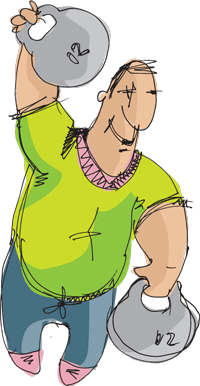UPDATE - We've received and decided to publish an official rebuttal to this article. Both are valuable. It's recommended that you read this first before moving onto the rebuttal via this link (also linked below)
I recently made the short trip to Syracuse where I gave a talk to some high school coaches about the benefits of strength training for their athletes. After the presentation, I went and got a free five-minute massage from one of the massage therapist on staff.
 After the massage one of the therapists began to talk about my posture. She picked me apart and came to the conclusion, with just her eyes mind you, that I had a leg length discrepancy and would tear my left biceps within a year.
After the massage one of the therapists began to talk about my posture. She picked me apart and came to the conclusion, with just her eyes mind you, that I had a leg length discrepancy and would tear my left biceps within a year.
It was interesting being on the other side of an assessment and it made me think about some of the major flaws in our assessment system -- not just for personal trainers but also for massage therapists and physical therapists.
Going on my fifth year as a personal trainer and strength coach, I was always taught to look at posture and movement "deficiencies" as the culprit for poor performance and future or current pain.
I listened to the advice of people like Janda and Cook -- Janda talking about posture and pain and Cook talking about movement and pain -- and basically regurgitated it in my first year teaching a personal training class at SUNY Cortland.
However, after years of training, I'm starting to wonder, "is posture important?" It's caused me to change how I address and work with new clients.
First, let me describe for trainers of what it's like to be a new person in a gym.
You've never lifted weights; frankly this is the first time you've stepped into a gym. To put it lightly, you're self conscious (read terrified) but you want to start living a healthier lifestyle. If you're at a commercial gym you've already gone through the unnecessarily stressful process of deciding which package you'd like to purchase. After that you're introduced to a personal trainer who's going to help you for a couple sessions, although you know he/she is going to try to sell their services to you at the end of the free sessions.
In the first session they tell you to stand against this weird grid thing that looks like what the cops use for a mug shot.
This trainer makes you face forward, turn, face backwards and then turn to the side again. They might even take a picture of you from every angle. Once that's done they might tell you that you have something called a thoracic kyphosis. You're not sure what that means but apparently it's going to make your back and shoulders hurt unless it gets fixed right away.
Next the trainer breaks out this board and a dowel and explains they're going to do a movement assessment. If you don't do well on this movement assessment you're probably going to hurt yourself. As you squat the trainer grimaces and writes a one down on their paper and deems you dysfunctional.
After that hour is over, your trainer goes over what they found and you schedule another appointment. You leave the gym and get into your car; you try to keep your back straight because God forbid if you slouch your shoulders could explode. Once you get home you're intently aware of how poor your movement is and that scares you as a professional just declared you dysfunctional.
I'm going to let you all in on a little secret: for most clients new to exercise posture and movement assessments do not matter -- being a positive, encouraging, and effective coach does.
Posture Posturing?
People often as me "is posture important" and I've had this debate countless times. When I do one of three things usually happens: One, the person accepts the evidence; two, the person is skeptical, reads the evidence and then accepts the evidence (best approach); or three the person yells at me, regurgitates some pseudoscience and holds even stronger to their beliefs without looking at the evidence.
If you've trained enough people you'll know that posture doesn't have an implication in pain. I've trained people with "normal" posture with low back pain and I've trained people with "bad" posture with no pain. Making people think about the small deviations in their posture really has no purpose.
Furthermore -- and yes I know this might sound like heresy -- I believe the efforts spent on changing posture are futile unless the client is truly committed to the change. In a literature review on posture, Eyal Lederman states that, "In the context of postural-structural-biomechanical (PSB) factors, it is expected that tremendous forces, well above the daily physical stresses, would be required to reposition/adjust/correct any structural misalignments.
These would have to be applied on a daily basis over several months or even years. A termination of treatment is likely to result in rapid reversal of PSB gains, unless the individual is able to self maintain them by specific exercise. The winner in the competition-in-adaptation, is ultimately the one most practiced, that is, the default PSB state/behavior of the individual" (1).
The posture you adapt is reflective of what you do every day, so to change posture you'd have to not only be cognizant of it every second but also change everything you do.
There's an obsession amongst trainers over pelvic tilts and doing whatever we can to correct it. These pelvic tilts might just be a natural variation with no effect on pain and little effect on performance. I'd wager that most trainers have little to no idea on how to measure a pelvic tilt.
Fact is, in one study with 120 asymptomatic participants, the experimenters found that,"Out of the 65 male subjects tested 55 (85%) presented with an anterior tilt, 4 with a posterior tilt and 6 presented as neutral. Across the sample of female subjects 41 presented with an anterior tilt (75%), 4 with a posterior tilt and 10 presented as neutral" (9).
Now, there may come a point where the tilt becomes so large that it may cause a problem but if such a large percentage of people are in an anterior tilt with no pain, why are we making such a big deal out of it?
 Multiple studies have eroded this pseudoscience away but it seems to cling on like a zombie! For example, one study found that, "Patients with chronic low back pain had no more standing lumbar lordosis or pelvic inclination than their counterparts with healthy backs" (2).
Multiple studies have eroded this pseudoscience away but it seems to cling on like a zombie! For example, one study found that, "Patients with chronic low back pain had no more standing lumbar lordosis or pelvic inclination than their counterparts with healthy backs" (2).
In another study, the authors concluded that, "The correlations between all measurements were so low that abdominal muscle function, pelvic tilt, and lumbar lordosis do not appear to be linked as inextricably as has been proposed" (3). If you look at the research the abdominals are almost quiet in standing activities so it seems implausible to blame them for any sort of pelvic tilt (3,4).
In a study that looked at upper body alignment it was discovered that, "A number of individuals with normal posture were found to have significant pain, whereas some individuals with more severe postural deviations in the thoracocervical- shoulder region were found to have minimal pain" (5).
Sticking with the upper body? Surely slouching forward affects performance and can induce pain? I won't make an argument against performance -- an easy self experiment can show that if you slouch forward it becomes harder to reach overhead.
One study found that "improving" improving posture for people with impingement increased the amount of pain free range of motion but found that "the intensity of pain was not found to be significantly reduced" (6). That being said, they discovered that some subjects in the postural intervention group actually had "detrimental effects on shoulder" (6).
Finally, in a new review on scapular positioning and pain it was concluded that, " Non-surgical treatment involving rehabilitation of the scapula to an idealized normal posture is not currently supported by the available literature" (7).
Movement Screen Obfuscation?
The functional movement screen has some merit. I love the deep squat and the push-up, and I think those are two great screens to garner a baseline as to where your client is at. Unfortunately, its efficacy really hasn't been evaluated when it comes to the general population.
I used the FMS for a couple years before I came to the conclusion that no newbie is going to do well on this test. Just by looking at new clients and listening to their exercise experience I could predict how they would do on the screen and would always come to the same conclusion: they just need to be coached!
Having them do an inline lunge, hurdle step, and rotary stability test yielded highly unusable information. So I started skipping the screen and just went on to teaching the movements I used with all of my clients.
I'd teach the squat pattern and figure out where they were at in terms of performance. If the squat wasn't where I thought it should be I'd move them to a box squat and eventually progress to the goblet squat and then onto a back squat if they made it there. Same concept with the push-up and deadlift.
These exercises are going to be a staple of every program I put together. Contrary to popular belief, not every client is a snowflake.
So the problem with screening new people on the FMS is that you're putting them through a test you know they're going to fail, so what's the point when you could get all the information you need simply by coaching?
But what about athletes? That's a different story.
I still don't see its efficacy as I don't believe that it correlates over to athletic performance, and the evidence to rule out injury is mixed (I'll link a great review below). In one test on NFL players it was discovered that the FMS has a relatively low sensitivity, meaning that just because someone passed the test they couldn't rule out injury in the future (8).
Continuing with sports I'll quote physical therapist Jonathan Fass:
"If you want to evaluate for potential injury risk, then do so with testing that's been validated with your specific population, not a general screen that may be quite meaningless (for instance, drop tests are validated "screens" for ACL injuries").
Concessions
Should we worry about posture and movement screens for high performance athletes? In the first paper mentioned Lederman makes some concessions to posture stating that:
"In sports extreme physical demands combined with underlying postural-structural-biomechanical issues may increase the likelihood of low back pain" (1).
It would be an oddity to find a high performance athlete who had severely "abnormal" posture. That being said, we run into the issue as to what "abnormal" posture is? Would noticing that a boxer is kyphotic and attempting to correct it even be a good idea? Odds are that adaptation for the boxer helps them with their sport. Whatever adaptations made an athlete elite shouldn't be changed.
In another study on a protracted scapula position and shoulder anterior instability, the authors concluded that "repetitive or chronic protraction of the scapula may result in excessive strain and, ultimately, insufficiency in the anterior band of the inferior glenohumeral ligament" (10). It should be noted, however, that this study was done on cadavers.
Finally, if a client wants to change their posture for aesthetic purposes that is perfectly acceptable. Part of a trainer's job is to help people look better, so if a client exhibits concerns about their appearance point them in the right direction to attempt to make postural improvements.
As for the movement screen, I believe it may be useful for new trainers as sort of an intro to screening. I believe it is a good idea to clear movement, if a client has trouble with a movement screen they probably shouldn't be loaded up. I simply question if the FMS is necessary to discover this. There are certainly some great aspects of the screen -- as I mentioned before I always coach the squat so naturally it is a screen; same with the push-up.
PTDC head coach Jonathan Goodman and Mike Reinold collaborated on an article that talks about the problems with assessments. Click www.theptdc.com/2013/03/most-personal-trainers-shouldnt-do-assessments-how-to-collaborate/ to open in a new window and read that one afterwards.
However, instead of things like the inline lunge -- which I will never instruct someone to do -- just coach a regular lunge. I can still get a lot of information out of that. Do they load up the quad? Do they go into valgus? I've thrown away the rotary stability exercise because new people aren't going to get a three -- I don't even get a three. Instead I do a plank assessment because that tells me a lot about abdominal and low back muscle endurance.
When working with higher performance clients I want to know more about them. The information I want has to do specifically with what they want to improve their performance at. The FMS might be a decent place to start as sort of the ground level of screening.
However, if I'm working with a powerlifter I'd be more concerned about their form under load than their inline lunge. For a basketball player or football player strength, agility, and vertical testing would probably give me better data about their athletic performance. In the end though, the only way to really gauge athletic performance is to watch your athletes perform!
Posture and Movement Screening Isn't All That Important
I realize that this view point goes against the grain and challenges what most trainers have been told. Rather than focusing on posture and corrective exercises that we have needlessly made a necessity in the industry, focus on coaching proper exercise form, work within the limits of the client, and progress whenever possible.
UPDATE: The Official Rebuttal
We've received a great rebuttal to this article and have published it so that you can learn both sides of the spectrum and come to your own conclusion. Please read the rebuttal by clicking here.
References
(1)Lederman E. The fall of the postural-structural-biomechanical model in manual and physical therapies: Exemplified by lower back pain. Journal Of Bodywork & Movement Therapies . April 2011;15(2):131-138.
(2)Youdas W., Garrett T., Egan K., Therneau T. Lumbar lordosis and pelvic inclination in adults with chronic low back pain. Physical Therapy. 80: 261-275, 2000
(3)Walker M., Rothstein J., Finucane S., Lamb R. Relationships between lumbar lordosis, pelvic tilt, and abdominal muscle performance. Journal of American Physical Therapy. 67: 512-516, 1987
(4)Lederman E. The myth of core stability. Journal Of Bodywork & Movement Therapies . January 2010;14(1):84-98
(5)Griegel-Morris P., Larson K., Mueller-Klaus K., Oatis C. Incidence of common postural abnormalities in the cervical shoulder and thoracic regions and their associations with pain in two age groups of healthy subjects. Journal of the American Physical Therapy Association. 72: 425-431, 1992
(6)Lewis J., Wright C., Green A. Subacromial impingement syndrome: The effect of changing posture on shoulder range of movement. Journal of Orthopaedic & Sports Physical Therapy. 35: 72-87, 2005
(7)Ratcliffe E., Pickering S., McLean S., Lewis J. Is there a relationship between subacromial impingement syndrome and scapular orientation? A systematic review. British Journal of Sports Medicine. 2013
(8)Kiesel K., Plisky P. Voight M. Can Serious Injury in Professional Football be Predicted by a Preseason Functional Movement Screen? N Am J Sports Phys Ther. August; 2(3): 147-158, 2007
(9)Herrington L. Assessment of the degree of pelvic tilt within a normal asymptomatic population. Manual Therapy . 16(6):646-648, 2011
(10)Weiser W, Lee T, McMaster W. Effects of simulated scapular protraction on anterior glenohumeral stability. American Journal Of Sports Medicine. 27(6):801-805, 1999
FMS review- http://www.strengthandconditioningresearch.com/2013/12/19/fms/











